The Diving tank is an essential piece of scuba diving equipment that allow divers to explore the underwater world by supplying them with compressed air to breathe.
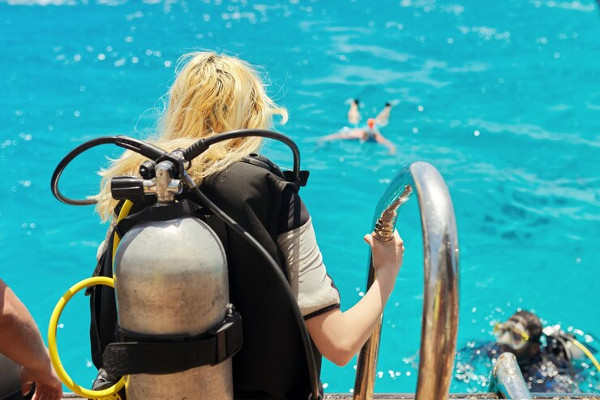
These tanks come in various sizes, materials, and configurations to suit different diving needs and preferences. It’s crucial for divers to understand the properties and maintenance requirements of their tanks to ensure a safe and enjoyable diving experience.
In this guide, we’ll discuss the key characteristics of diving tanks, how to properly maintain them, and factors that affect their prices.
How much does a scuba tank weigh?
Have you ever wondered how much a scuba tank weights?
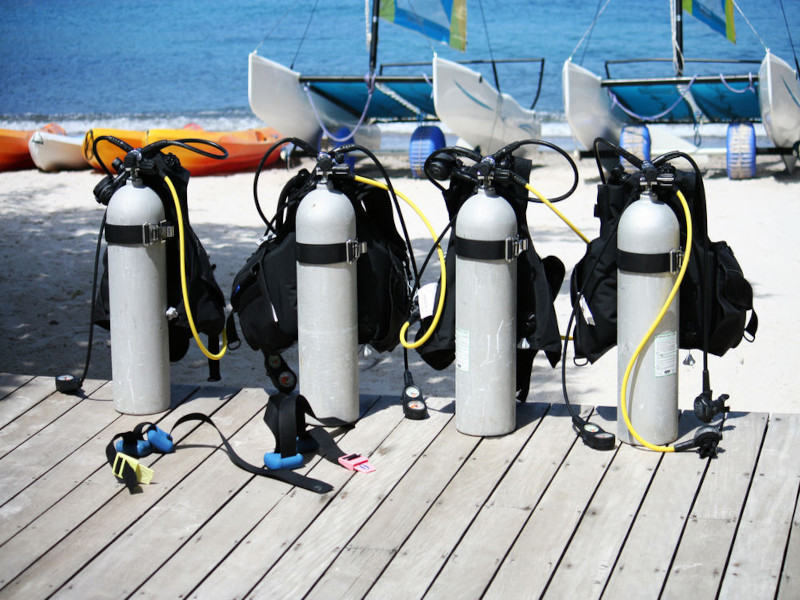
A typical scuba tank is 12 liters in volume and 230 bar pressure and unfilled will weigh around 16kg (35 lbs).
The factors that affect weight are, tank size, pressure, and material.
A filled tank with compressed air and a valve will add around 3.5kgs to the total weight.
Here is a comparative table of manufacturers with their corresponding weights.
| Model | Volume | Pressure | Material | Weight (kg) |
| Dir Zone | 12L | 230 Bar | Steel | 13.8 |
| Faber | 12L | 232 Bar | Steel | 13.6 |
| Beaver | 12L | 232 Bar | Steel | 16.0 |
| Beaver | 12L | 300 Bar | Steel | 16.0 |
| Faber | 15L | 232 Bar | Steel | 18.0 |
| ScubaPro | 12L | 232 Bar | Steel | 15.1 |
| BTS | 12L | 300 Bar | Steel | 18.0 |
| Luxfer | 11.1 | 207 Bar | Aluminium | 16.0 |
| MES | 11.1 | 207 Bar | Aluminium | 14.3 |
Surely the tank is the heaviest part of the diving equipment.
The complete diving equipment, and even if the tank is empty, it easily weighs around 22 kilos
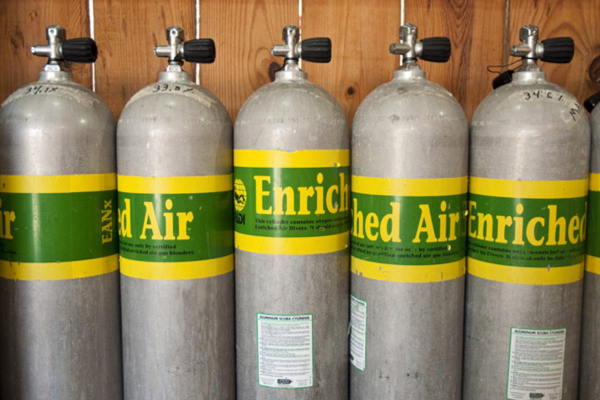
How much heavier is a full scuba tank?
There are several scientific formulas for calculating the weight of gas.
Here is the more common.
Gas weight of air (in kg) = 0.0012 x pressure in bar x volume in liters
With these formulas, you can calculate how much above the base weight you will be carrying if the tank is filled.
They have high buoyancy, which makes easier to reach neutral buoyancy.
- 12 liter tank at 232 bar is 0.0012 x 232 x 12 = 3.34kg of air
- 12 liter tank at 300 bar is 0.0012 x 300 x 12 = 4.32kg of air
- 11.1 liter tank at 207 bar is 0.0012 x 207 x 11.1 = 2.75kg of air
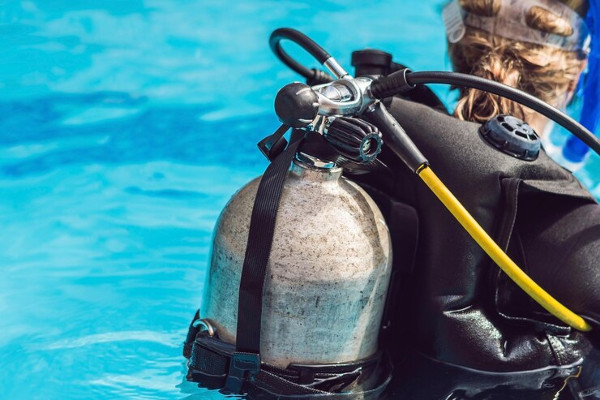
Scuba diving tank sizes
About sizes, they are standardized among divers around the world. Here are three of the most commonly used scuba tanks sizes.
Their sizes are generally measured by the air capacity they carry. The unit is in cubic feet.
100 CU FT, 232 BAR
This steel cylinder is the most commonly used among all divers.
They come in two sizes (different dimensions), but that should not affect the price of filling them because they carry the same amount of air.
● 80 CU FT, 207 BAR (S80)
The material of this is aluminium. This a little smaller scuba tank is more use by recreational divers.
The cost of filling a scuba tank is not fixed. It really depends on what you fill it with.
● 25 CU FT, 232 BAR (EMERGENCY CYLINDER)
This type is use as an emergency reserve. Normally it goes on the side of the main tank. It is small and compact.
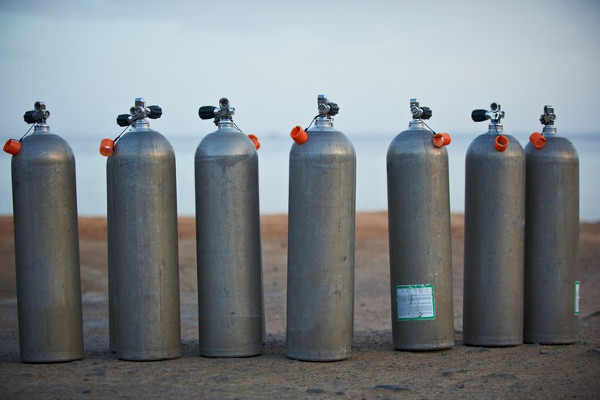
How long can a scuba bottle last?
Many of those who are starting in the world of diving have this question. How long can I use a scuba bottle underwater?
To have the approximate time you must make a calculation taking into account the depth in which you plan to dive and the oxygen expenditure that you will have.
To make this calculation, Boyle and Mariotte’s law is used. As an example, we can say that a cylinder filled with twelve liters of oxygen can
take about twenty-five minutes.
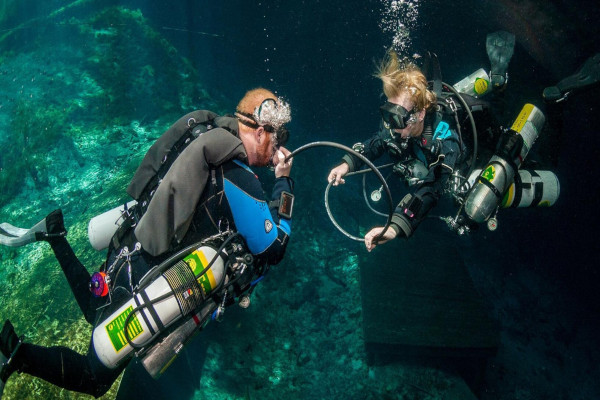
Read also: Diving in Costa Rica
What about cost and prices?
There are various factors that affects price. Here is a table for a reference.
Prices
| Gas Type | Capacity | Price |
|---|---|---|
| Nitrox | 0-40 cu ft | $3-9 |
| Nitrox | Up to 80 cu ft | $5-20 |
| Nitrox | Up to 100 cu ft | $7-27 |
| Nitrox | Up to 120 cu ft | $10-$32 |
What is a scuba tank filled with?
The scuba tank contains a mixture of gases that emulate the air we normally breathe.
These gases are compressed at a pressure of 200 or 300 bars depending on their characteristics, so that they come out with force when we open the faucet and to store a greater volume.
Notice that the Compressed air is a mixture of 21% oxygen, 78% nitrogen and a portion of water vapor.
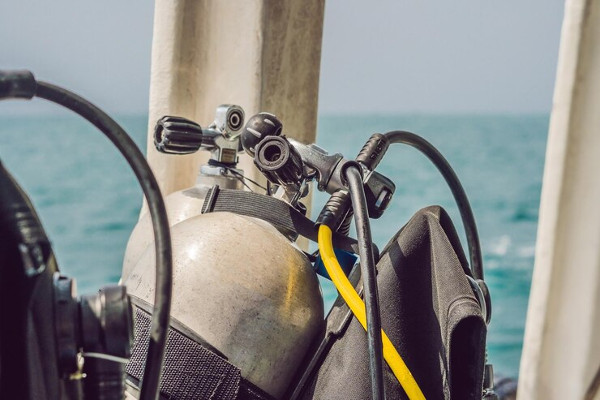
Diving tank – Scuba diving gas mixes
Many people incorrectly call the scuba tank an oxygen tank. Although it seems only an expression, it is important that you know that divers can also breathe other gases.
The more commons are nitrox, as well as technical mixes.
What’s the difference between all these scuba diving gas mixes?
Air
Almost all dive centers use air as gas for diving. Air is 79 Percent Nitrogen, 21 Percent Oxygen
The main reason is that it contains enough oxygen to keep us underwater, and since we find it all around it is relatively cheap.
The problem is that during our descent and bottom time, our tissues are absorbing nitrogen.
On ascent, the tissues release this extra nitrogen in a process called off-gassing. Nitrogen loading limits recreational divers’ bottom times and how fast they can ascend.
The downside is that during our descent and bottom time, our tissues are absorbing nitrogen.
In the way up, the tissues release this extra nitrogen in a process called off-gassing.
Nitrogen loading limits recreational divers’ bottom times and how fast they can ascend. There are depth limitations when using air. The reason is that nitrogen becomes narcotic as it goes deeper. Therefore, the maximum depth for recreational diving is 40 meters, or 130 feet, which is the equivalent.
In relation to the cost, it is almost always included in the diving packages. For the filling sometimes they charge a small canon.
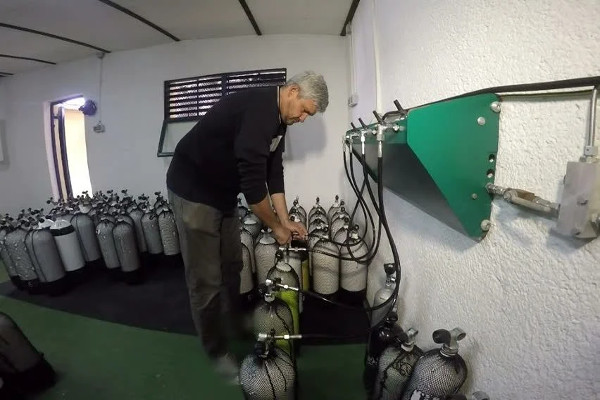
Nitrox
Enriched Air, also called Oxygen Enriched Air, or just Nitrox.
Nitrox contains from 22 to 40 percent oxygen. The most common mixes are 32% and 36% oxygen. They are also known as EAN32 and EAN 36.
Some new divers have the idea that with nitrox they will be able to dive deeper and stay underwater longer.
This theory is not correct. Nitrox is a shallow diving gas. What nitrox does allow is to extend the no decompression limit, compared to air.
Since nitrox contains more oxygen, it contains less nitrogen. This means your body absorbs less nitrogen at a given depth compared to diving in air. This explains why you can extend your NDL(No Decompression Limits).
But staying down longer with less nitrogen in the tank will still produce the same decompression risk as using air for less time at a given depth.
Considering that oxygen becomes toxic with increasing depth, every nitrox mixture has a maximum depth for a particular dive, with shallower maximums than air.
This is one is most widely available of scuba diving gas mixes.
About the cost, dive shops usually charge per cylinder.
EANx / Nitrox and Oxygen Fill Prices.
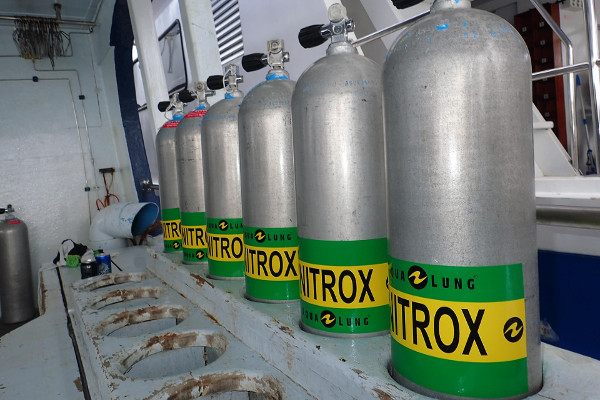
| Item | Price |
| Tanks-A-Lot Fill Card | $50.00 |
| Enriched Air Fill (32% O2) | $12.00 |
| Enriched Air Fill (Custom 22% to 40% O2) | $18.00 |
| Oxygen 0-40 Cubic Feet | $25.00 |
| Oxygen per cubic foot (40 Cuf or More) | $0.65 per cubic foot |
Trimix
When we talk about trimix we are in the area of technical diving.
Trimix is a mixture of oxygen, nitrogen and helium.
Why adding helium? Well, we know that nitrogen becomes narcotic as we go deeper.
Helium is an inert gas, meaning it does not react with our bodies at conventional scuba depths.
So if we replace some of the nitrogen with helium, we can go deeper and still have a clear head.
So-called normoxic trimix does allows divers to do just that. A common mixture is 21/35, which has 21 percent oxygen, 35 percent helium and 44 percent nitrogen.
Another common mixture is 18/45, with 18 percent oxygen and 45 percent helium. These mixtures allow technical divers to hang around at up to 197 feet (60 m) — and actually remember their dive.
Dives any deeper than 197 feet require hypoxic trimix. In this mixture, helium replaces some of the nitrogen and oxygen content.
Doing so reduces the risk of oxygen toxicity at depths of around 328 feet (100 m). A typical hypoxic mixture at this depth would be 10/70 (10 percent oxygen and 70 percent helium).
Helium is quite expensive, and the cost of filling tanks will vary greatly depending on the depth and equipment configuration.
People who do a lot of deep diving use rebreathers to keep gas costs down.
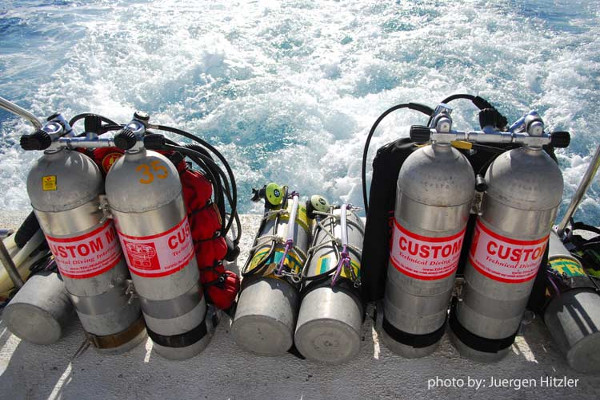
See also Scuba tank: the essentials
Decompression gases: Nitrox 40 to 99% AND 100% Oxygen
This type of gas is for qualified technical divers. It is for technical diving courses.
You will need to be qualified as advanced nitrox/Tec 40, or Tec45 diver/decompression procedures to rent tanks.
Decompression gas is a little more expensive than nitrox.
What are diving oxygen tanks made of?
Diving cylinders tanks are usually manufactured from aluminium or steel alloys.
When used on a scuba set are normally fitted with one of two common types of cylinder valve, used for filling and connection to the regulator.
The manufacture of the aluminum bottle begins by cutting an aluminum cylinder.
The size will depend on the final size of the bottle but is usually 1/3 of the final size.
The material is cleaned, washed and centrifuged to then go through a process that under pressure molds the body of the diving bottle.
Steel vs Aluminum Scuba Cylinders
- Steel scuba diving tanks are the final product of the process named “deep draw”. The “deep draw” process involves a high-quality chrome-molybdenum steel blank drawn into the form with a machined punch.
- Steel cylinders are more resistant than aluminum cylinders.
- The production of a steel cylinder requires less raw material than that of aluminum.
- In the production of steel cylinder there is less material waste.
- Steel scuba tanks have a lower overall weight and better buoyancy characteristics. This means that Steel tanks change from negative to neutral buoyancy during a dive, allowing the diver to have a more consistent weight and finish the dive better balanced.
- Steel scuba tanks are the preferred choice for many divers because the buoyancy feature helps dry suit diving.
- Steel diving cylinders have working pressures between 232 bar and 300 bars. Diving cylinders rated for 300 bars are heavier as they have thicker walls to be stronger.
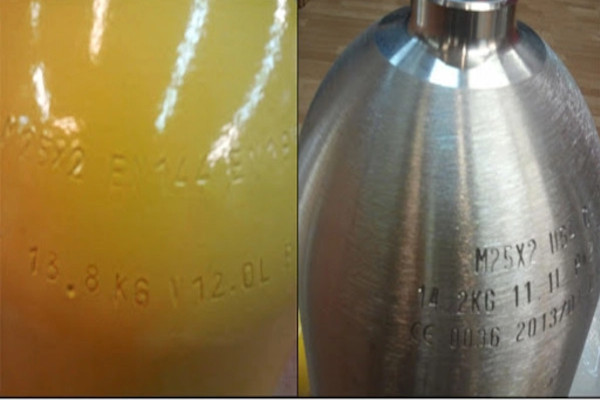
Diving tank – How often do scuba tanks need to be tested?
The answer is every five years. A visual inspection is required every year, and a hydrostatic test is required every five years. The visual inspection is a non-invasive examination of the tank’s exterior and interior, including the neck, threads, and valve. During the inspection, the inspector checks for signs of rust, corrosion, and any other damage that could compromise the tank’s integrity.
On the other hand, the hydrostatic test involves placing the tank in water and increasing the pressure to determine if it can withstand the pressure. The test also checks for leaks and weaknesses in the tank’s metal walls. If the tank fails either test, it cannot be used for scuba diving until it is repaired or replaced.
It is essential to note that scuba tanks should not be tested or maintained by untrained individuals. Only certified technicians should perform inspections and tests. A certified technician will have the necessary tools, knowledge, and experience to ensure the scuba tank is safe and ready to use.
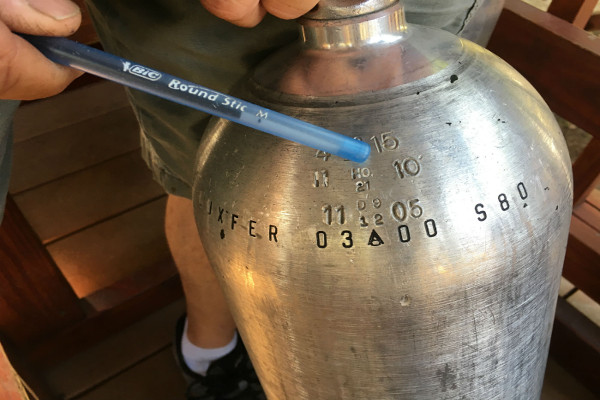
Diving tank Maintenance
Scuba Diving Cylinder Visual Test
One of the biggest problems affecting scuba cylinders is moisture, which corrodes and makes the cylinder weaker.
According to the studies carried out, the corrosion in the cylinders that are used to fill them with pressurized air and nitrox advances a hundred times faster than another container of pressurized elements.
The useful life of a well-maintained steel cylinder can be 40 years. The aluminum scuba cylinder can serve up to 20 years, or 1,000 pressure tests.
In practice a tank rarely reaches that level.
New cylinders are hydrostatically tested before leaving the factory, and this date is engraved on the cylinder head. For example: 2022/02 (year 2022, month of February)
Today’s standards require visual testing of scuba cylinders every 2 and a half years.
What do they look for in the visual tests?
Visual tests is about checking for protrusions, corrosion and cracks. The general condition of the cylinder and the valve are verified.
When the tank passes the test, a sticker is placed on it, usually blue or green, which contains the date of the check and the date of the next test.
The useful life of a cylinder, in practice, really depends on many factors. That’s why it’s so important to test regularly, and not to fill up the tank if in doubt.
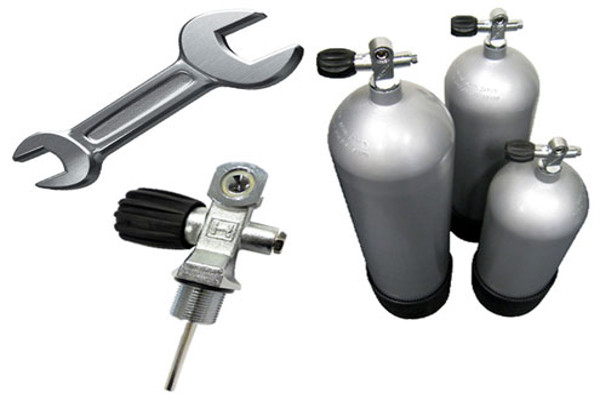
Scuba Diving Cylinder Hydrostatic Test
Diving cylinders must be hydrostatically tested every 5 years in Europe. This can vary a little bit from place to place.
Before the hydrostatic test, the visual test must be carried out. That is, the visual test is part of the hydrostatic test, and precedes it.
How a hydrostatic test is performed. The scuba cylinder is pressurized to a higher degree than its normal working level, and the volume of the cylinder is measured before and after pressurization.
If there is an increase or variation in the volume of the diving cylinder, it means that the cylinder has failed the test and must be withdrawn from circulation.
Once the test has been passed, the regulatory body in charge of carrying out the test places a sticker on the bottle, which indicates the date of the test, and also the date of the next inspection.
Tips for maintenance air cylinders
Here are some tips to take into account when thinking of diving tank maintenance:
- Take care to secure your tank at all times, so it does not fall or roll, thereby injuring others, damaging equipment, or even yourself.
- Do not let them empty completely. Always leave them with air inside to prevent moisture from forming.
- Remember to rinse the bottle and faucet with fresh water and store them in a cool place.
- Have your cylinder visually checked once a year and pressure checked as needed.
- Follow the maintenance considerations according to the manufacturer’s instructions.
Diving tank – How to refill diving tank rust
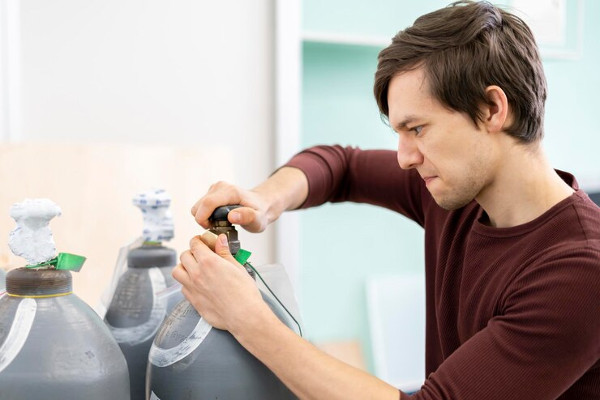
You can purchase tanks from a scuba shop and refill them as long as they are in good and working condition.
People usually fill diving tanks with compressed air.
This compressed air must be breathable, that is, treated so that it can be used for human breath.
Depending on the use of the bottles, you can fill them with air at a pressure between 200 and 300 bar.
How long should a scuba regulators last?
The correct functioning of the regulator depends on the proper maintenance that it has.
Therefore, our advice is to take the regulator to an authorized service center for inspection at least once a year.
You might have to replace the valve every two years or every 200 diving hours.
